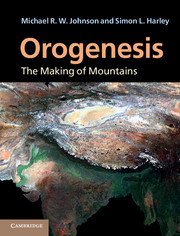Book contents
- Frontmatter
- Contents
- Preface
- Acknowledgments
- Geological timescale
- 1 Major features of the Earth and plate tectonics
- 2 Driving mechanisms for plates, slab retreat and advance, and a cause of orogenesis
- 3 Physical and chemical principles: rock deformation, isostasy, geochronology and heat production in the lithosphere
- 4 Large-scale features of orogens: thrusts and folds
- 5 Evolution of orogens
- 6 Lateral spreading of orogens: foreland propagation, channel flow and weak zones in the crust
- 7 Metamorphism in orogeny
- 8 The erosion and exhumation of mountains
- 9 Sedimentary history of the foredeep basins
- 10 Deep structure, mountain support and phase changes
- 11 Mountains and climate
- 12 Secular change in orogeny
- References
- Index
- Plate section
Preface
Published online by Cambridge University Press: 05 June 2012
- Frontmatter
- Contents
- Preface
- Acknowledgments
- Geological timescale
- 1 Major features of the Earth and plate tectonics
- 2 Driving mechanisms for plates, slab retreat and advance, and a cause of orogenesis
- 3 Physical and chemical principles: rock deformation, isostasy, geochronology and heat production in the lithosphere
- 4 Large-scale features of orogens: thrusts and folds
- 5 Evolution of orogens
- 6 Lateral spreading of orogens: foreland propagation, channel flow and weak zones in the crust
- 7 Metamorphism in orogeny
- 8 The erosion and exhumation of mountains
- 9 Sedimentary history of the foredeep basins
- 10 Deep structure, mountain support and phase changes
- 11 Mountains and climate
- 12 Secular change in orogeny
- References
- Index
- Plate section
Summary
Preface
Mountains have attracted the attention of mankind at least since Rousseau (or did Petrarch precede him?*) who devoted much thought to nature, perhaps because the height and scale of mountains induced a sense of awe. A love of nature showed itself in the fairly recent desire to get to the top of mountains. George Mallory gave his reason for wanting to climb Everest as “because it is there”, but long before that mountains were important for humankind, because they formed natural barriers for trade and the movement of armies. Perhaps the ancient Egyptians tried to simulate mountains in the pyramids of Giza. The same is true of builders of Gothic cathedrals, which were built ever higher so as to imitate mountains which reach up to heaven. The Greeks worshipped the gods on Mount Olympus, and mountains appeared often in Greek mythology; Prometheus, for example, was chained to a mountain side. The Greeks saw mountains as mysterious and frightening places, and even today for Hindus and Buddhists there are sacred mountains in the Himalaya such as Nanda Devi, Kailas and Everest – Qomolungma, the goddess mother of the Earth. Badrinath near the source of the Ganges in the High Himalaya is the home of the gods and a place of pilgrimage. Moses came down from a mountain bearing his famous tablets. Noah is supposed to have docked his ship on Mount Ararat. The Bible states “the mountains shall melt before the Lord” (Judges 5:5), but perhaps the reference was to volcanoes rather than orogenic mountains.
Many artists, too, have been fascinated by mountains. Leonardo Da Vinci realised that the fossils in the rocks of the Apennines showed that the rocks were once below sea level, and he and other painters used mountain scenes as backgrounds. Cezanne painted many pictures of Mont St. Victoire in Provence.
- Type
- Chapter
- Information
- OrogenesisThe Making of Mountains, pp. vii - viiiPublisher: Cambridge University PressPrint publication year: 2012

